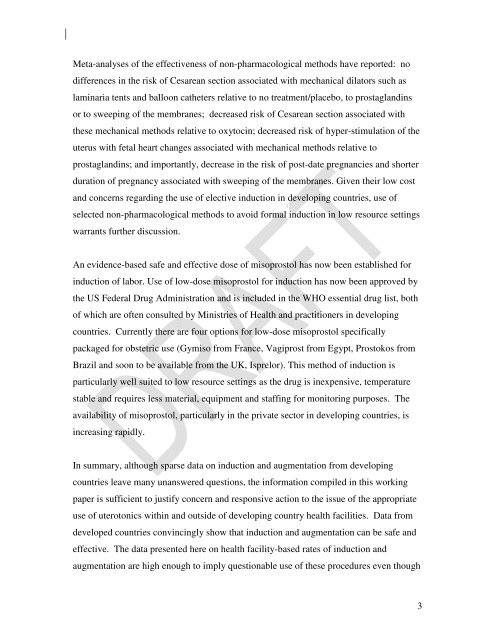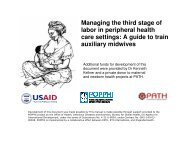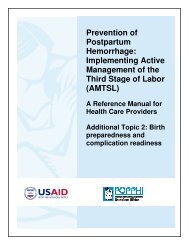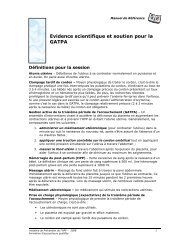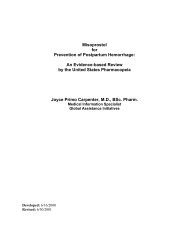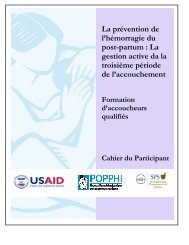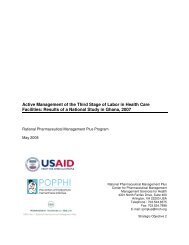Use of oxytocin and misoprostol for induction or ... - POPPHI
Use of oxytocin and misoprostol for induction or ... - POPPHI
Use of oxytocin and misoprostol for induction or ... - POPPHI
Create successful ePaper yourself
Turn your PDF publications into a flip-book with our unique Google optimized e-Paper software.
Meta-analyses <strong>of</strong> the effectiveness <strong>of</strong> non-pharmacological methods have rep<strong>or</strong>ted: no<br />
differences in the risk <strong>of</strong> Cesarean section associated with mechanical dilat<strong>or</strong>s such as<br />
laminaria tents <strong>and</strong> balloon catheters relative to no treatment/placebo, to prostagl<strong>and</strong>ins<br />
<strong>or</strong> to sweeping <strong>of</strong> the membranes; decreased risk <strong>of</strong> Cesarean section associated with<br />
these mechanical methods relative to <strong>oxytocin</strong>; decreased risk <strong>of</strong> hyper-stimulation <strong>of</strong> the<br />
uterus with fetal heart changes associated with mechanical methods relative to<br />
prostagl<strong>and</strong>ins; <strong>and</strong> imp<strong>or</strong>tantly, decrease in the risk <strong>of</strong> post-date pregnancies <strong>and</strong> sh<strong>or</strong>ter<br />
duration <strong>of</strong> pregnancy associated with sweeping <strong>of</strong> the membranes. Given their low cost<br />
<strong>and</strong> concerns regarding the use <strong>of</strong> elective <strong>induction</strong> in developing countries, use <strong>of</strong><br />
selected non-pharmacological methods to avoid <strong>f<strong>or</strong></strong>mal <strong>induction</strong> in low resource settings<br />
warrants further discussion.<br />
An evidence-based safe <strong>and</strong> effective dose <strong>of</strong> <strong>misoprostol</strong> has now been established <strong>f<strong>or</strong></strong><br />
<strong>induction</strong> <strong>of</strong> lab<strong>or</strong>. <strong>Use</strong> <strong>of</strong> low-dose <strong>misoprostol</strong> <strong>f<strong>or</strong></strong> <strong>induction</strong> has now been approved by<br />
the US Federal Drug Administration <strong>and</strong> is included in the WHO essential drug list, both<br />
<strong>of</strong> which are <strong>of</strong>ten consulted by Ministries <strong>of</strong> Health <strong>and</strong> practitioners in developing<br />
countries. Currently there are four options <strong>f<strong>or</strong></strong> low-dose <strong>misoprostol</strong> specifically<br />
packaged <strong>f<strong>or</strong></strong> obstetric use (Gymiso from France, Vagiprost from Egypt, Prostokos from<br />
Brazil <strong>and</strong> soon to be available from the UK, Isprel<strong>or</strong>). This method <strong>of</strong> <strong>induction</strong> is<br />
particularly well suited to low resource settings as the drug is inexpensive, temperature<br />
stable <strong>and</strong> requires less material, equipment <strong>and</strong> staffing <strong>f<strong>or</strong></strong> monit<strong>or</strong>ing purposes. The<br />
availability <strong>of</strong> <strong>misoprostol</strong>, particularly in the private sect<strong>or</strong> in developing countries, is<br />
increasing rapidly.<br />
In summary, although sparse data on <strong>induction</strong> <strong>and</strong> augmentation from developing<br />
countries leave many unanswered questions, the in<strong>f<strong>or</strong></strong>mation compiled in this w<strong>or</strong>king<br />
paper is sufficient to justify concern <strong>and</strong> responsive action to the issue <strong>of</strong> the appropriate<br />
use <strong>of</strong> uterotonics within <strong>and</strong> outside <strong>of</strong> developing country health facilities. Data from<br />
developed countries convincingly show that <strong>induction</strong> <strong>and</strong> augmentation can be safe <strong>and</strong><br />
effective. The data presented here on health facility-based rates <strong>of</strong> <strong>induction</strong> <strong>and</strong><br />
augmentation are high enough to imply questionable use <strong>of</strong> these procedures even though<br />
3


